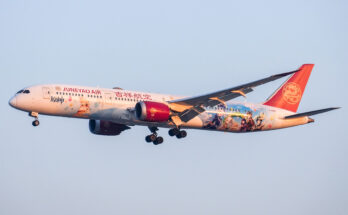by Richard Pettibone, Aerospace & Defense Companies Analyst, Forecast International.
With the glory days of the recent record-setting boom a memory, both Boeing and Airbus are adapting their operations as they prepare for flatter growth while ramping up production of new models.
Boeing had 668 net orders for 2016, compared to 768 net orders in 2015 and 1,432 in 2014. The company has a backlog of more than 5,700 airliners – mostly the new 737 MAX – to build over the coming years. For the year, Boeing reported sales of $94.6 billion, down 2 percent from the record sales of $96.1 billion in 2015. Net income for 2016 was $4.9 billion, down 5 percent from $5.2 billion in 2015.
This cooling is part of the aerospace manufacturing cycle. Since the 2008 recession, this market has – up until recently – outperformed the economy as a whole. The boom was driven in large part by high fuel costs; hence, sales of both Airbus’ NEO and Boeing’s MAX aircraft skyrocketed as airlines sought to replace older aircraft. Now that crude oil prices have collapsed, some airlines are deferring replacement of older aircraft. This softening is to be expected, as the wild order ride could only last for so long. As it stands now, both manufacturers have accumulated sizable order backlogs representing nearly a decade’s worth of production at current build rates.
The difficulty the firms are now facing is the management of extensive global supply chains. The pressure on supply chains to meet the demands of delivering highly engineered components in increasing quantities and on just-in-time schedules will be intense. Cracks in this system have appeared in the past and have rippled through the assembly lines, leading to delivery delays. Oversight and communication between the primes and their subs will be key in hitting delivery targets in the years to come.
Boeing currently plans to raise its 737 production rate from 42 per month today to 47 and 52 during 2017 and 2018, respectively. In early 2016, Boeing’s CEO, Dennis Muilenburg, announced that demand supports a further increase to 57 737s per month in 2019.
Not all Boeing models have shared in the recent boom. The company is struggling to bridge the gap in production between its current-generation 777 (777F and 777-300ER) and the future 777X to maintain the current production rate. The 777 is a very profitable aircraft for Boeing and an important cash cow. It will be difficult for the company to bridge the gap, as not enough orders are coming in for the current-generation 777. In 2016, Boeing’s gross orders for the aircraft dropped to 23 from a record high of 283 in 2014. As a result, the company plans to cut production in August 2017 from seven planes per month to five, and in 2018 the rate will drop further to 3.5 planes per month. The transition in production from current models to the 777X coincide with these declining build rates, as the 777X will not be delivered until 2020.
Marking the end of an era, Boeing revealed in a regulatory statement that it might close the 747 line after almost 50 years of production. Demand has shifted from large aircraft such as the 747 to smaller twin-engine widebodies. However, in late October 2016, UPS signed up for 14 747-8 freighters, with options for another 14 in the future. This order helped push up the backlog and extend the production line into the next decade at a rate of six per year.
While commercial aviation adapts to a slowing market, defense is preparing for interesting times with the new Trump administration in the White House. The new president has wasted no time in attacking high-cost defense programs, and Boeing was not spared.
President Trump blasted Boeing over the costs of two new Air Force One planes and threatened to cancel the program. He later met with Boeing CEO Muilenburg, who said he had “made some great progress” in face-to-face talks on the president’s demand to hold down costs on the new Air Force One program. The two also discussed the possibility of competing the F-18 against Lockheed Martin’s F-35, another program Trump criticized as costing too much.
All large government contractors are on tenterhooks as they deal with the new commander in chief. With presidential Twitter postings able to influence stock prices – albeit only temporarily — companies will nevertheless be stepping carefully as they negotiate with the new administration.
Blowback from the administration’s actions could impact orders from China, Iran and Iraq in the year ahead. The executive order on travel limits issued in January has injected a great deal of uncertainty for the future of at least one deal – the multibillion-dollar order from Iran Air. Looking ahead, should the U.S. pull out of the 2015 nuclear accord and re-impose sanctions, the deal will be DOA.
Overall, Boeing’s defense business has suffered as of late. In response, the company has consolidated its defense operations. In a major shift, Boeing has decided to move its defense services and support work out of the high-cost Seattle, Washington, area to the lower-cost regions of St. Louis, Missouri, and Oklahoma City, Oklahoma. With many of Boeing’s defense programs complete or slowing, the move was necessary.
Current defense programs will not be able to make up the lost revenue. For example, the KC-46 tanker program has razor-thin margins and is being hammered by cost overruns that Boeing must bear. Further, the company will fight tooth and nail for the few procurement programs remaining. In early 2016, Boeing and partner Lockheed Martin’s protest over the selection of Northrop Grumman for the Long-Range Strike Bomber (LRS-B) was denied.
As such, Boeing is now excluded from all next-generation military aircraft design and manufacturing work. C-17 production is complete and the company’s F/A-18 and F-15 programs are winding down, with nothing to replace them. Speculation was rampant that Northrop might be acquired by Boeing as it seeks to maintain a role in the lucrative military aircraft market. However, the Pentagon would likely not be too keen on this deal, should it materialize, owing to fears over reduced competition.
The next big competition, for the USAF T-X trainer, is currently moving along to a decision in late 2017. A Boeing/Saab team has developed a clean-sheet design to meet the service’s requirements. The Boeing/Saab team’s bid will need to build in the cost of developing a new aircraft, but by going with a new design the team will be able to tailor it precisely to T-X program requirements. Recent news reports quoted Boeing and Saab as stating that they expected to market their design globally regardless of a USAF win. While the global trainer market is strong, a win in the U.S. would give the program tremendous economies of scale. Further, many nations will follow the U.S. lead in trainer selection, especially if they operate F-35s. As rival competitors have dropped out, it appears that this program will be a shoot-out between Lockheed Martin and Boeing for the prize.
Like many other defense contractors, Boeing is looking abroad for more sales. Nevertheless, competition will be fierce as every other defense contractor in the world executes the same play. The 2015 loss of a $1.26 billion South Korean tanker bid is a prime example of how heated the market has become.
The Defense & Aerospace Companies series focuses on worldwide aerospace and defense prime contractors and subcontractors. Concise reports provide data on individual corporations regarding recent mergers, restructurings, and joint ventures, along with a Strategic Outlook that examines the company’s strengths, weaknesses, and opportunities. Also included in each report are financial and industrial segment data, snapshot coverage of major programs, and recent U.S. Department of Defense contract awards.
A military history enthusiast, Richard began at Forecast International as editor of the World Weapons Weekly newsletter. As the Internet grew in importance as a research tool, he helped design the company's Forecast Intelligence Center and currently coordinates the EMarket Alert newsletters for clients. Richard also manages social media efforts, including two new blogs: Defense & Security Monitor, covering defense systems and international issues, and Flight Plan, which focuses on commercial aviation and space systems. For over 30 years, Richard has authored the Defense & Aerospace Companies, Volume I (North America) and Volume II (International) services. The two books provide detailed data on major aerospace and defense contractors. He also edits the International Contractors service, a database that tracks all the contractors involved in the programs covered in the FI library. More recently he was appointed Manager, Information Services Group (ISG), a new unit that encompasses developing outbound content for both Forecast International and Military Periscope.




